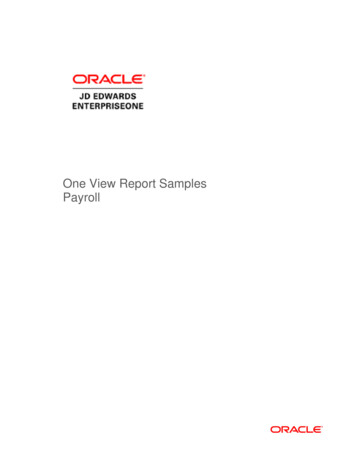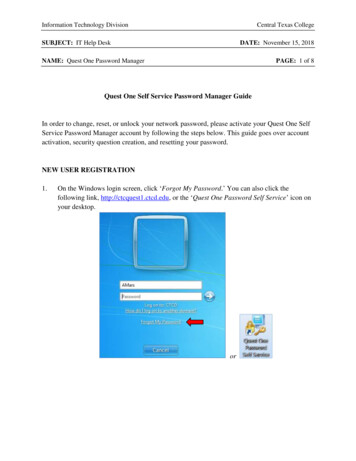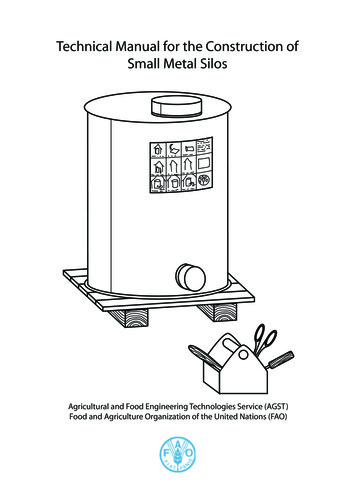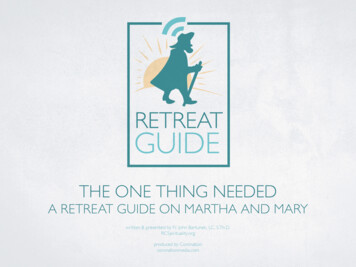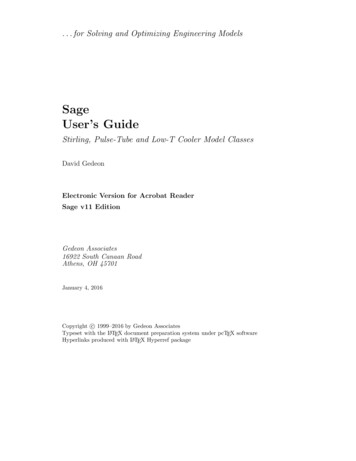
Transcription
.-;tirecord guide to one of the most challenging of today's fingerpicking guitar styles, featllri&the sounds and syncopations of ragtime-the music that became jazz.Demanstratian6'6i,@?Recard Insideb.%,a''.L4cations.-.-, rI.;*,
"It is the music of the hustler, of the feverishlyactive speculator; of the sky-scraper and the grainelevator."-The Thunderer, March 19 13"Ragtime and other dances come from the underworld in New Orleans."-The Literary Digest, August 1917"Since ragtime, people are much more given t o excitement and drink ."-Francis ToyeThe English Review, 1913"Ragtime is poison."-Carl Muck, svmphonv conductorThe Literary Digest, January 19 1 6"Ragtime was an important event in American culture, its best performers were serious popular artists .properly performed it is still a wonderfulmusic."-Martin Williamsdown beat, November 1971"America's one distinct contribution t o music isragtime ."-Carl Van VechtenCurrent Opinion, November 1917w"Ragtime. A style of American popular musicwhich originated at the end of the 19th century,one of the earliest known examples being the "Harlem Rag" of 1895. It probably derived from theearly minstrel show tunes of the 1840's and frommarches, especially those improvised for street parades in New Orleans. It reached its peak about1910-1915, afterwards merging into jazz."-Harvard Brief Dictionary of MusicThis manual was designed t o be of use to guitarists at alllevels of proficiency. Although the material is thoroughlyprofessional-both in terms of musicality and in challengesto technique-yet for the beginner, the accompanying demonstration record, the clear and easy notational system,and the wealth of detailed instructional analysis, make itpossible for him at the very outset to take serious stepstoward creating a professional solo sound.
Although the sophisticated and syncopated musical style known as ragtime, has been around,in one form or another, for something like a hundred years, it is only quite recently thatguitar players have begun adding ragtime pieces to their repertoires to any great extent.Originally written t o be performed by pianists and bands, the typical rag does not reduceeasily t o the physical requirements of the guitar; and it may have been for this reason alonethat guitar players-with rare exception-long avoided the style.In any case (and notwithstanding the work of such contemporary guitarists as Rev. GaryDavis and Doc Watson), it was the guitar explosion of about a dozen years ago that actuallygave impetus to the ragtime guitar movement.For never before, at one time, had so many young guitarists suddenly become available t oexplore the labyrinthine possibilities of the instrument. "Folkies," in quantities hitherto undreamed of, picked and fretted their way through the standard library of fingerstyle material, and many of them, having acquired new technical abilities which far exceeded the relatively simple demands of such old standbys as "Freight Train," and "Railroad Bill," beganto look elsewhere for musical challenge.It was natural that ragtime, with its off-beat rhythms and jazz-like harmonic complexity,should have attracted these new pioneers of the guitar. And natural that their efforts shouldhave resulted in what has today become a steadily-growing body of recorded work that isgaining wider and wider appreciation among a general audience.So much for a capsule history of ragtime guitar. As far as the guitarist is concerned, ragtimetechnique is tricky and demanding-perhaps as demanding, ultimately, as that of the classical guitar.This book is the first to present the interested student/guitarist with an organized approachto the ragtime style and to attempt a codification of the style's many techniques. Thus, inthe Index of Ragtime Guitar Techniques (found on p. 78), such newly-coined words andphrases as "Overfretting," and "Guide Strings," are attempts to describe and explain guitartechniques never before treated in print. The inclusion, with the book, of a demonstrationrecord which augments and clarifies discussions in the text, is also a first in the ragtime field.I t is hoped that this book will prove useful not only to those guitarishinterested solely inthe ragtime style, but also to those interested in tracing back the roots of jazz, and thosewho are merely fascinated by the seemingly endless varieties of technique possible on thatmost adaptable of musical instruments, the guitar.
Raatirne Ramble: Recard Band 3/Side A(measure 2){\(measure 3 )(measure 2)@Green Note Music Publications 1974All Rights Reserved
Analysis: Measures 1-6%.Make sure that you are fingering the chords as shown in the chord diagrams above the music, and thatyou understand how both fretting and picking instructions are notated throughout the book.IPlaying the last note in measure 2 with the middle finger of the fretting hand puts you in a goodposition to move smoothly into the G7 chord in measure 3 .IIn measure 3 , it is not necessary t o grab the entire G7 chord on the first beat of the measure. Youcan play just the bass note at first, reserving the notes shown in grey on the chord diagram for placement on the next beat.This "building up" of chords for ease of fingering is a practice widely used in the ragtime guitar style,and we point out examples of this wherever it occurs throughout the text.IIn measure 6 , the note in parentheses is played the first time through on the record, but not thesecond.Measures 6-7 [see "Overfretting," p. 261 .IIn measure 7, the note in parentheses is omitted the first time through on the record, and played thesecond time.IMeasure 8 [see "Fretting With the Thumb," p. 26, and "The Hammer," p. 281Also in measure 8 , notice the use of the secondary picking arrangement (discussed earlier on p. 1 3 ) .
Recard Band 3/Side ARaatime Ramble (cont'd)(measure 3 )(measure 2)(measure 3 )A n a l s i s :M e a s u r e s 9-12IIn measure 12, you might experience some difficulty in changing smoothly from the G7 t o the E7chord.The following are some points t o keep in mind when you have trouble making a particular chord changein the ragtime style:
1) know when to lift fretting fingers, as well as when t o set them down2) hold notes common t o both chords wherever possible3 ) "build up" the chord that you're going to, by degrees, rather than grabbing it all a t onceFigs. IB-3B, below, show these principles applied t o the chord change occurring between measures11-12.LL1Fig. 1 B. Lift fingers, keeping cornmon note.Fig. 2B. "Building up" the chord./Fig. 3B. The final, abbreviated, E7chord.As shown in Fig. I B , as you pick the last note in measure 11, lift the middle and ring fingers of t h efretting hand. This frees the fingers for later use and also opens the bottom string for use o n the firstbeat of measure 12. Notice that the pinky remains, holding a note common t o both chords.Fig. 2B shows the middle finger of the fretting hand being placed o n the second beat of measure 12.You can wait t o place this finger until the second beat, or else fret the note-without picking it-duringsome part of the first beat of the measure. In either case, you are "building up" the chord by frettingthe notes only as they are needed.Fig. 3B shows the index finger hammering down o n the third beat of the measure, t o complete the E7chord. This version of a "first fret" E7 chord may not be as full as the one you are accustomed t o playing or seeing, but in this case, additional notes were not needed.Finally, in measure 12, note the hammer with simultaneously-picked bass note. We discussed this typeof move earlier, in connection with measure 8 of this solo; here the same instructions apply.
Raatime Ramble (cont*d)(measure 16)Recard Band 3/Side A(measure 15)(measure 15)D767
@ Analysis:M e a s u r e s 13-18IMeasure 1 3 [see "Damping," p. 271Also in measure 1 3 , notice once again the use of the thumb as a fretting finger. T o make an easy changefrom the F t o the D7 chord, simply slide the thumb of the fret hand from the first t o the second fret,and lift the ring finger from the fourth string. The index and middle fingers remain where they are,holding common notes.IIn measure 14, the C chord is somewhat different from the Cchord we have encountered thus far. Can you guess why this particular bass note is used here? A hint: follow the stepwise motionof the bass part along the sixth string, beginning in measure 13.Getting good movement in the bass line is an important part of constructing tight ragtime solos.Also in measure 1 4 , you can accomplish the transition to the Achord with relative ease simply by grabbing the half-barre formslightly in advance of the beat, as shown in Fig. 4B.Incidentally, you may remember a few measures ago we showedsome advantages to fretting only those notes of a chord that wereactually needed (Analysis: measure 1 2 , p. 2 1 ) . In measure 1 4 , notall of the notes of the barred A chord are actually picked, yet inthis case, because of t h e ease in fretting, it makes sense t o use thisform of the chord, rather than some "purer" one.!Fingerpicking style guitar continually presents you with such situations. In each case, your choice should be based on what you canplay easiest, while at the same time producing the best sound.\/Fig. 4B. Anticipated chan e, usingthe half-barre A c ord.fAfter measure 16, follow the repeat sign back t o the beginning, and repeat through measure 15. Skip the first ending a t measure 16 the second time; go instead t o the secondending a t measure 1 7 , and finish the solo.1
Raatime Ramble (cont'd)(measure 15)(measure 16)C(measure 19)(measure 2 1)Record Dand 3/Sick A
-q b n a l v s i s : M e a s u r e s 19 22IIn measure 20, notice the use of the secondary picking arrangement.Also in measure 20, the change from the G to the G7 chord is a quick one, and might give you sometrouble. Take advantage of the open-string note located between these two chords to help you makethis quick change. Figs. 5B-7B show how this is done.Fig. 5B. The G chord.Fig. 6B. Moving to the G 7 chord,while picking the open t o pstring.;BFig. 7B. The G 7 chord.Often, just such an open-string note between two chords enables you t o accomplish easily what wouldotherwise be a difficult change.IThe final chord in measure 22 can either be plucked with the thumb and fingers, or strummed witha short downward motion of the thumb.
Extended Discussians::To play the last note of measure 6 and the first note of measure 7, simply move the entire Cchord form that you have been fretting, stepwise up the fingerboard, as shown in Figs. 8B-IOB,below. By doing so, you accomplish the transition from measure 6 to measure 7 with a minimum of fret hand movement. We call this technique "overfretting" because by holding a fullchord at the time that you are playing the single-string stepwise bass line, you are fretting morenotes than you actually need. [Return t o p. 19, second from end.]D7onIIIciwi\Fig. 8B. Full C chord in measure 6.Iwtt4TabA-,L#.1 LFig. 9B. The same form moved upone fret.Fretting With the ThumbIn measure 8 of this solo, aswell as a number of timesthroughout this book, thethumb of the fretting hand isused to fret notes on the bottom string, in the mannershown in Fig. 1 IB.but in other styles of guitarplaying (perhaps because nonclassical guitar necks are usually slimmer) the practice isfairly common. A number ofchords cannot be formed except by resorting t o this technique.This use of the thumb is traditionally frowned upon, especially by classical guitarists,[See now "The Hammer," p. 28.1IJFzg. 1 OB. Into the 0 7 chord, measure 7 .Fig. 1 IB. Thumb fretting the bott o m bass string.I
DampineNotice in the recording how all four chords in measure 13 have an abrupt, cut-off sound t othem. This is a result of "damping" the strings immediately after each chord is plucked.There are a number of different ways t o damp strings. The most common way is simply t o release the pressure of the fretting fingers, allowing the strings t o rise to their normal heightabove the fingerboard. Strum or pluck the F chord in measure 1 3 . Immediately after thechord sounds, release the pressure of the fretting fingers. Do not take your fingers from thestrings entirely; merely let the strings rise until the sound abruptly ceases. You will find thatthis method of damping works well with the first three chords in measure 1 3 . However, the lastchord in this measure uses an open string, over which the fretting hand normally has no control.In order t o damp open strings, you must use some part of your pick hand. One method involves returning the fingers t o the strings immediately after plucking them. For example, playthe last chord in measure 1 3 . Immediately bring back the thumb, middle, and index fingers t otouch the sounding strings, in the manner shown in Fig. 128: as if you were going t o play thechord again. Touching the strings in this way should effectively damp them. (Right now, justfor experimental purposes, d o not damp by relaxing the fingers of the fretting hand. Instead,let the pick hand d o all the damping.)Oftentimes, strings thathave not been pluckednevertheless pick up thevibrations of plucked onesand produce a "sympathetic" sound of theirown. For example, in theD7 chord you just played,you may have noticed thatthe fifth string could beheard sounding a thin toneoneoctave above its norFig. I2B. Damping with the fingersma1 pitch, seemingly allof the pick hand.by itself. Refer again toFzg. 12B, and notice how the thumb, in damping the fourth string, can also touch the fifthstring, thus cutting o u t potential unwanted sound from that source as well. (It's also possibleif you pluck this D7 chord hard and listen closely-to hear the open sixth string sound. However, in this case, the effect is really t o o slight t o matter much.)Another way of damping open strings is t o use the heel of the pick hand, bringing it down t otouch the stri
This book is the first to present the interested student/guitarist with an organized approach to the ragtime style and to attempt a codification of the style's many techniques. Thus, in the Index of Ragtime Guitar Techniques (found on p. 78), such newly-coined words and phrases as "Overfretting," and "Guide Strings," are attempts to describe and explain guitar techniques never before treated .

